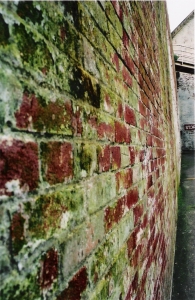Mold Removal
Our Mold Removal Services:
 Microtech Environmental Services Corp. has specialized in Mold Removal since 1992. Our technicians are the most highly-trained in the industry. Metro New York, New Jersey, and Connecticut are the areas we service.
Microtech Environmental Services Corp. has specialized in Mold Removal since 1992. Our technicians are the most highly-trained in the industry. Metro New York, New Jersey, and Connecticut are the areas we service.
Before removing the mold, we create a restricted area. We isolate, contain, and seal it off. A commercial grade air filtration system (HEPA) is run to avoid air contamination and restore IAQ (Indoor Air Quality). Dehumidifiers and deodorization are also used. Our technicians use PPE / personal protective equipment (hazmat suit, respirator, etc.).
Microtech’s technicians meticulously cleanup, eliminate, and remove mold and any porous mold contaminated items. Special commercial-grade antimicrobial cleaners are used. Professional grade encapsulant sealants are applied to prevent future contamination.
We recommend cleaning your HVAC (heating, ventilation, and air conditioning) in conjunction.
Medical Problems:
Once exposed to the mold, your body remembers the cause and produces antibodies. Histamine, which causes inflammation, is produced and causes allergy and cold symptoms. Symptoms of mold exposure are below.
Fungal Infection (Mycosis or Mycoses plural) can be either
- Subcutaneous Mycoses (skin, tissues, muscle)
- Systemic Mycoses:
- primary pathogens (lungs, organs)
- opportunistic pathogens (already weakened patient, especially those with a compromised immune system and existing lung disease, that produces illness)
Mold Allergy Symptoms:
- Breathing Difficulties (e.g. shortness of breath, wheezing)
- Sinus Congestion and Pain including headache, facial pain, achy teeth
- Runny Nose
- Coughing (yellow or green mucus, phlegm)
- Wheezing
- Itchy, Burning, Red, Watery Eyes
- Skin Rash
- Fever
- Fatigue (lethargic, tired, malaise)
- Dizziness (worse when bending over)
- Nausea
Mold Poisoning:
- Allergies (allergic rhinitis, AFS allergic fungal sinusitis, fungal sinusitis, EFRS eosinophilic fungal rhinosinusitis, EMRS eosinophilic mucin rhinosinusitis)
- Sinus Infection (rhinosinustis)
- Asthma
- Bronchitis
- Pneumonia
- COPD (chronic obstructive pulmonary disease)
- Hypersensitivity Pneumonitis (lung inflammation)
- Alveolitis (lung or dental inflammation)
- Chronic Lung Disease
- Toxic Dust Syndrome (pulmonary mycotoxicosis, from moldy agricultural products)
- Memory Loss / Mental Impairment (Depression, Anxiety)
- Internal Organ Damage
- Lung Cancer, Scarring, and Death
Black Mold Poisoning:
- Fast Heart Rate (tachycardia), Agitation
- Headache
- Skin Rash, Jaundice (yellowing)
- Itchy Eyes, Blurry Vision
- Breathing Difficulties, Respiratory
- Circulatory Problems
- Nausea
- Lethargy, Tired
- Mental, Depression, Anxiety
- Inhibited Protein Synthesis
- Immune System Problems
- Reproductive System Problems
- Cancer
- Death
Mycotoxin Poisoning (Mycotoxicosis) or Black Mold Poisoning is when the toxic fungi (Mycotoxin) chemicals from the mold are absorbed into the intestinal lining, skin, and airways. Black mold (aflatoxin) is the most well known and most carcinogenic (cancer producing). Other Myotoxins are ochratoxin, citrinin, ergot, patulin, and fusarium.
Aspergillus Diseases (caused by Aspergillosis)
- Aspergillus Flavus Toxins, Aflatoxin Mycotoxins, which are a powerful carcinogen (cancer), ends up in the liver. These toxins caused Turkey X Disease
- Allergic Bronchopulmonary Aspergillosis (ABPA) causes inflammation of the lung airways, which damages the lung tissue and can cause permanent scaring. The symptoms are wheezing, coughing up blood (hemoptysis), recurring infections that are antibiotic resistant
- Acute Invasive Aspergillosis surrounds tissue. Weakened immune patients are most susceptible
- Disseminated Invasive Aspergillosis is an infection that spreads throughout the body
- Aspergilloma forms in lung cavities
Pnemonitis causes inflammation of the very small airways in the lungs. The symptoms from Pnemonitis are similar to pneumonia with shortness of breath, coughing, body aches, malaise, fever, chills, lung scarring, and fibrosis.
The lymphatic system and blood stream may carry the mold toxins all over the body.
Indoor Mold Locations:
Water Damage (leaks, condensation)
- Basement Flood | Flooding
- Roof Leak
- Pipe Leak
- Plumbing Leak
- Sewage
- Sink Leak
- Hot Tub Leak
- Dishwasher Leak
- Washing Machine Leak
- Shower Mist
- Humidifier Mist
- Metalworking Mist
- HVAC Leak (Heating, Ventilation, Air Conditioning): Ductwork
- Fire Extinguishing Water Damage (fire hydrant and hose water damage)
- Other: Fiberboard, Gypsum Board, Ceiling Tile, Paneling, Wallpaper, Drywall, Insulation, Chimney, Shower Stall, Fabric, Upholstery, Paper, Lint, Dust, Carpet, etc.
Natural Disasters can also cause Mold. Examples of naturally occurring disasters include Blizzard, Hurricane (e.g. Hurricane Katrina and Sandy), Flooding, Nor’easter, Super Storm, Moon Tides, Earthquake, Dam Break, Tsunami, etc.
Outdoor Mold Locations:
Outdoor Mold can be decomposing plant life such as hay, wood, dead trees, leaves, soil, esparto grass, and compost. Coccidiomycosis (soil fungus), histoplasmosis (bird and bat droppings fungus), and blastomycosis (wood and soil fungus) are the most aggressive outdoor molds.
Definitions:
Mold can negatively impact your health and cause property damage.
Mold is a microscopic fungi that replicates by forming spores in damp, humid, warm places. Usually there is an odor to the mold.
Mildew is usually white or gray mold found in bathrooms, tubs, showers; living plants; or organic matter (such as wood, paper, and leather).
Mycotoxin is the toxic chemical produced by fungi and bacteria. Mycotoxins are also known as fungal toxins.
Toxic Mold: Certain types of mold are considered toxic and emit mycotoxins, which cause the toxic reactions. Sustained and repeated exposure can cause severe medical problems.
Black Mold (greenish black color) is the most well known. Many black molds are toxic. Stachybotrys Chartarum (stachybotrys atra) is the most well known toxic black mold.
Other well known toxic mold is Alternaria, Aspergillus, Cladosporium, and Penicillium.
MVOC (microbial volatile organic compounds) create the strong odor smell.
Warning: We don’t recommend you try to remove the mold yourself, yet if you attempt to, be forewarned. If the medical problems aren’t scary enough, mixing Bleach and Ammonia or other cleaners can cause toxic, dangerous fumes.

